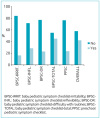SCREENING FOR NEUROPSYCHOMOTOR AND SOCIAL-EMOTIONAL DEVELOPMENT IN CHILDREN UNDER 24 MONTHS OF AGE IN THE BRAZILIAN SEMI-ARID REGION
- PMID: 34076203
- PMCID: PMC8240621
- DOI: 10.1590/1984-0462/2022/40/2020172
SCREENING FOR NEUROPSYCHOMOTOR AND SOCIAL-EMOTIONAL DEVELOPMENT IN CHILDREN UNDER 24 MONTHS OF AGE IN THE BRAZILIAN SEMI-ARID REGION
Abstract
Objective: To screen children under 24 months of age for neuropsychomotor and social-emotional development in a municipality of the Brazilian semi-arid region, using the Survey of Well-Being of Young Children (SWYC) scale.
Methods: This is a quantitative cross-sectional study with a non-probabilistic sample, involving children aged 1 to 24 months and their respective mothers, recruited from primary care services in the municipality of Picos, Piauí, Northeastern Brazil. The screening for neuropsychomotor and social-emotional development using the SWYC scale also provided information about the family context. In addition, we administered a questionnaire to assess the children's demographic and socioeconomic factors. Descriptive data analysis was performed.
Results: The sample consisted mostly of adult mothers (84.0%), with more than 8 years of schooling (83.3%), belonging to the C, D, and E socioeconomic classes (75.3%). The prevalence of suspected cases of delayed neuropsychomotor development and social-emotional changes was 12.7 and 42.2%, respectively.
Conclusions: The results point to the existence of children at risk of delayed development, particularly in the social-emotional domain, reaffirming the need to adopt child development screening as a health service routine, with the implementation of appropriate intervention programs.
Objetivo:: Realizar a triagem para desenvolvimento neuropsicomotor e socioemocional em crianças menores de 24 meses, em município da região do semiárido brasileiro, utilizando a escala Survey of Wellbeing of Young Children (SWYC).
Métodos:: Estudo transversal, com abordagem quantitativa, amostra não probabilística, envolvendo crianças entre 1 e 24 meses e suas respectivas mães, selecionadas em serviços de saúde da atenção básica do município de Picos, Piauí. A triagem do desenvolvimento neuropsicomotor e socioemocional com uso da escala SWYC também forneceu informações sobre o contexto familiar. Além disso, utilizou-se questionário para avaliar fatores demográficos e socioeconômicos das crianças. Realizou-se a análise descritiva dos dados.
Resultados:: A amostra foi constituída de mães em sua maioria adultas (84,0%), com mais de oito anos de estudo (83,3%), pertencentes às classes socioeconômicas C, D e E (75,3%). A prevalência de casos suspeitos de atraso no desenvolvimento neuropsicomotor e de alterações socioemocionais foi de 12,7 e 42,2%, respectivamente.
Conclusões:: Os resultados apontam a existência de crianças em risco de desenvolvimento, sobretudo socioemocional, reafirmando a necessidade da adoção da triagem para desenvolvimento infantil como rotina nos serviços de saúde, com a implantação de programas de intervenção apropriados.
Conflict of interest statement
The authors declare there is no conflict of interests.
Figures
Comment in
-
Comment on: Screening for neuropsychomotor and social-emotional development in children under 24 months of age in the Brazilian semi-arid region.Rev Paul Pediatr. 2022 Sep 9;41:e2021358. doi: 10.1590/1984-0462/2023/41/2021358. eCollection 2022. Rev Paul Pediatr. 2022. PMID: 36102404 Free PMC article. No abstract available.
Similar articles
-
"Survey of Wellbeing of Young Children (SWYC)": how does it fit for screening developmental delay in Brazilian children aged 4 to 58 months?Res Dev Disabil. 2018 Jul;78:78-88. doi: 10.1016/j.ridd.2018.05.003. Epub 2018 May 21. Res Dev Disabil. 2018. PMID: 29793101
-
Influence of exposure and vertical transmission of HIV-1 on the neuropsychomotor development in children.Rev Soc Bras Med Trop. 2019 Jan 14;52:e20180263. doi: 10.1590/0037-8682-0263-2018. Rev Soc Bras Med Trop. 2019. PMID: 30652795
-
Confirmatory analysis and normative tables for the Brazilian Ages and Stages Questionnaires: Social-Emotional.Child Care Health Dev. 2019 May;45(3):387-393. doi: 10.1111/cch.12649. Epub 2019 Mar 4. Child Care Health Dev. 2019. PMID: 30746738
-
Developmental delay--identification and management.Aust Fam Physician. 2005 Sep;34(9):739-42. Aust Fam Physician. 2005. PMID: 16184205 Review.
-
Ages and Stages Questionnaire: a global screening scale.Bol Med Hosp Infant Mex. 2017 Jan-Feb;74(1):5-12. doi: 10.1016/j.bmhimx.2016.07.008. Epub 2017 Jan 30. Bol Med Hosp Infant Mex. 2017. PMID: 29364814 Review.
Cited by
-
Comment on: Screening for neuropsychomotor and social-emotional development in children under 24 months of age in the Brazilian semi-arid region.Rev Paul Pediatr. 2022 Sep 9;41:e2021358. doi: 10.1590/1984-0462/2023/41/2021358. eCollection 2022. Rev Paul Pediatr. 2022. PMID: 36102404 Free PMC article. No abstract available.
-
Nutritional Knowledge about Maternal and Newborn Health among Physiotherapists during the COVID-19 Pandemic in Minas Gerais, Brazil.Nutrients. 2024 Jan 5;16(2):180. doi: 10.3390/nu16020180. Nutrients. 2024. PMID: 38257072 Free PMC article.
References
-
- Heckman J. Four big benefits of investing in early childhood development. [2020 Feb 20];The Heckman Equation. 2015 [homepage on the Internet] Available from: https://heckmanequation.org/
-
- Torquato IM, Dias HP, Lima AG, Faustino JK, Pontes FA, Jr, Maia MT. Child development surveillance: analysis of risk factors for children under two years. Educ Ci Saúde. 2019;6:65–80. doi: 10.20438/ecs.v6i2.237. - DOI
-
- Sun J, Liu Y, Chen EE, Rao N, Liu H. Factors related to parents’ engagement in cognitive and socio-emotional caregiving in developing countries: results from multiple indicator cluster survey 3. Early Child Res Q. 2016;36:21–31. doi: 10.1016/j.ecresq.2015.12.003. - DOI



